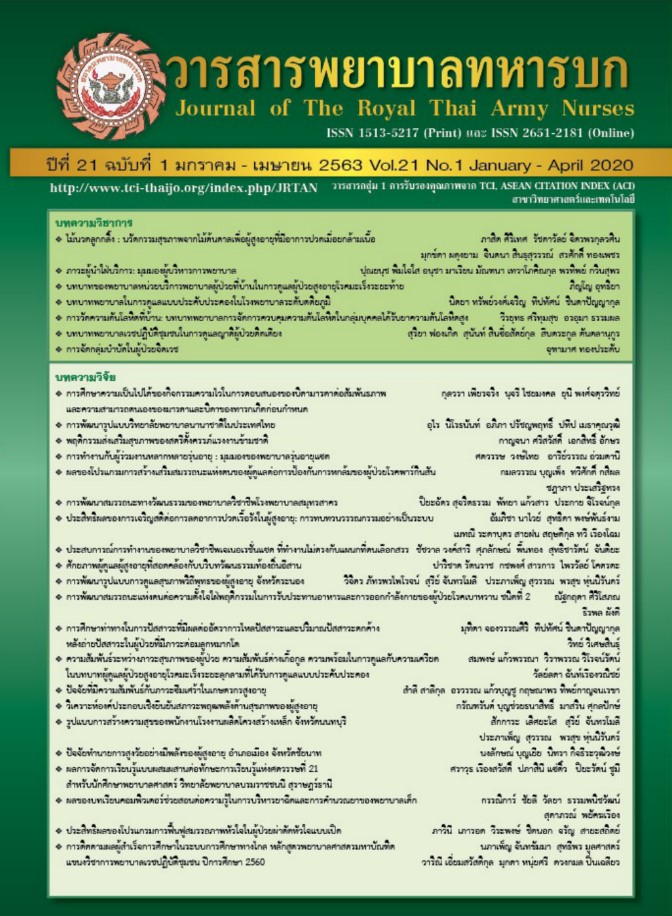The Effects of Self-Efficacy Promotion Program of Caregivers for Prevention Fall of Patient with Parkinson’s Disease
Keywords:
Caregivers, Self-efficacy promotion, Fall preventionAbstract
The research aimed to examine the effects of self-efficacy promotion program of caregivers for prevention fall of patient with Parkinson’s disease. Thirty outpatient samples were Parkinson’s disease caregivers who visited Parkinson clinic at the Chulalongkorn Center of Excellence for Parkinson’s Disease & Related Disorder of King Chulalongkorn Memorial Hospital. The samples were devided into 2 groups, which were fifteen persons on the experimental group and fifteen persons on the control group who received regular nursing care. Data were collected by using a self-efficacy of Parkinson’s disease caregiver’s questionnaire, which had Cronbach’s alpha at 0.98. Knowledge of caregivers in preventing falls was also applied as an instrument which had Kuder-Richardson (KR-20) at 0.96.
The research results found that before experiment, the experimental group who attended the training program and the control group, who received regular nursing care had no different on self-efficacy and knowledge on preventing fall in Parkinson’s disease. After experiment, the experimental group and control group had perceived self-efficacy and knowledge of the caregivers to prevent fall of patient with Parkinson’s disease had significantly different. Suggestion: the effects of self-efficacy promotion program of caregivers for prevention fall of patient with Parkinson’s disease can improve self-efficacy and knowledge for the Parkinson’s patient caregivers.
Downloads
References
Connolly, B. S., & Lang, A. E. Pharmacological treatment of Parkinson disease: a review. Jama 2014;311(16):1670-1683.
Bhidayasiri R, Wannachai N, Limpabandhu S, Choeytim S, Suchonwanich Y, Tananyakul S, Asawavichienjinda T. A national registry to determine the distribution and prevalence of Parkinson’s disease in Thailand: implications of urbanization and pesticides as risk factors for Parkinson’s disease. Neuroepidemiology 2011;37(3-4): 222-230.
Boonrowd N, Boonpang K, Bhidayasiri R.Parkinson’s Disease Nursing Handbook. Bangkok: Chulalongkorn Center of Excellence for Parkinson’s Disease & Related Disorder King Chulalongkorn Memorial Hospital 2016.
Miller N, et al. Life with communication change in Parkinson’s disease. Age and Ageing 2006;35:235-293.
Kamata N, et al. Overestimation of stability limits lead to a high frequency of fall in patients with Parkinson’s disease. Clinical Rehabitation 2007;21(4): 357-361.
Tuite P, Thomas C, Ruekert L, Fernandez H. Parkinson’s disease: A guide to patient care. New York: Springer Publishing. 2009.
Lindop F. A multidisciplinary approach to Parkinson’s disease. British Journal of Neuroscience Nursing 2012;8(2):61-4.
Duandporn C, Renu P, Pisamai O, Effect off Sele-Effect Promotion on Caregiver’s Confidence of Participation in child care before Discharge form Pediatric Intensive Care Unit. Journal of The Royal Thai Army Nurses. 2018;19 (3): 234-242 (in Thai).
Chuanchom, P. (2017) Fall in Parkinson’s Disease. Journal of Phrapokklao Nursing College. 28 (2) 165-172 (in Thai).
Downloads
Published
How to Cite
Issue
Section
License
บทความหรือข้อคิดเห็นใดใดที่ปรากฏในวารสารพยาบาลทหารบกเป็นวรรณกรรมของผู้เขียน ซึ่งบรรณาธิการหรือสมาคมพยาบาลทหารบก ไม่จำเป็นต้องเห็นด้วย
บทความที่ได้รับการตีพิมพ์เป็นลิขสิทธิ์ของวารสารพยาบาลทหารบก
The ideas and opinions expressed in the Journal of The Royal Thai Army Nurses are those of the authors and not necessarily those
of the editor or Royal Thai Army Nurses Association.






